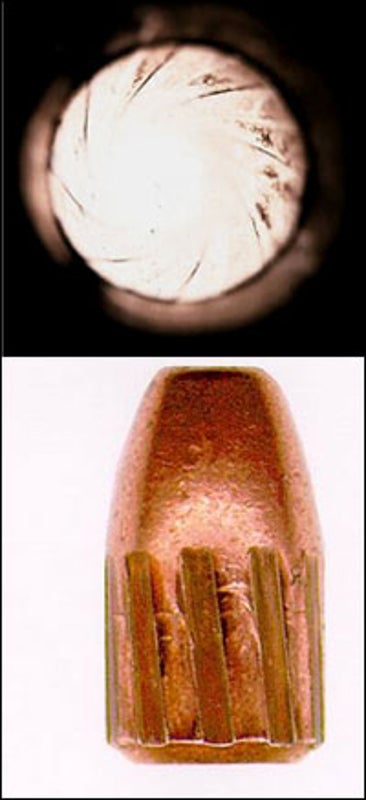Are Bullets Registered To Your Name

Ann L. Davis of the Virginia Division of Forensic Science and the Virginia Found of Forensic Science and Medicine, explains.
Near mod handguns and rifles are manufactured based on blueprints that specify their configurations. Ane of these specifications is a characteristic known equally rifling, which refers to the spiral lands and grooves placed into the firearm's barrel to impart a spin on the bullet for accuracy. The number of lands and grooves and the management in which they twist, either right or left, tin be determined by observing the rifling engravings in the butt. The image at right (pinnacle) shows the rifling in a barrel having eight lands and grooves inclined to the left, every bit seen from the cage-terminate of a firearm. The lands and grooves appear as raised and lowered areas, respectively, in the barrel. These rifling characteristics are and then imparted onto a projectile as it spins downwardly the barrel, leaving country and groove impressions on the fired bullet (bottom).
Manufacturers utilize diverse cutting, swaging and electrolytic processes to introduce rifling into a barrel, and these processes, as well as others used in the finishing of a firearm, make each barrel unique. A barrel will produce individual markings in addition to a bullet's state and groove impressions every bit the bullet passes through, and it is these unique markings that an examiner evaluates to make up one's mind whether a given bullet was fired from a detail firearm.
The rifling characteristics alone tin reveal what brand and/or model of firearm could have fired a specific projectile. To figure out if a bullet could have originated from a specific firearm, however, a forensic firearm and toolmark examiner uses an instrument called a comparison microscope to compare a questioned bullet (one recovered from a crime scene, for example) to bullets test fired from a doubtable firearm. Examiners generally test fire into a water recovery tank to obtain comparison bullets for evaluation under the microscope.
A comparison microscope comprises ii compound microscopes joined past an optical bridge and i gear up of eyepieces, or oculars. The configuration is such that the examiner can evaluate items on each of the microscope stages at the same time. A dividing line separates the two items in the field of view, and allows the examiner to vary how much of each item is observed simultaneously.
After evaluation of the test-fired bullets against one another for the presence of repetitive individual microscopic markings, the questioned bullet is mounted on the left stage and one of the test-fired bullets is placed on the correct stage. The examiner then assesses the questioned bullet for the aforementioned repetitive marks that are nowadays on the test projectiles. If sufficient correspondence is constitute betwixt the questioned bullet and the test bullets, with no unexplainable differences, the examiner can conclude that the questioned bullet was fired from the suspect firearm. The image above demonstrates corresponding microscopic markings consistent with two bullets having been fired from the same firearm.
Source: https://www.scientificamerican.com/article/how-can-a-bullet-be-trace/
Posted by: fitzgeraldshmed1969.blogspot.com


0 Response to "Are Bullets Registered To Your Name"
Post a Comment